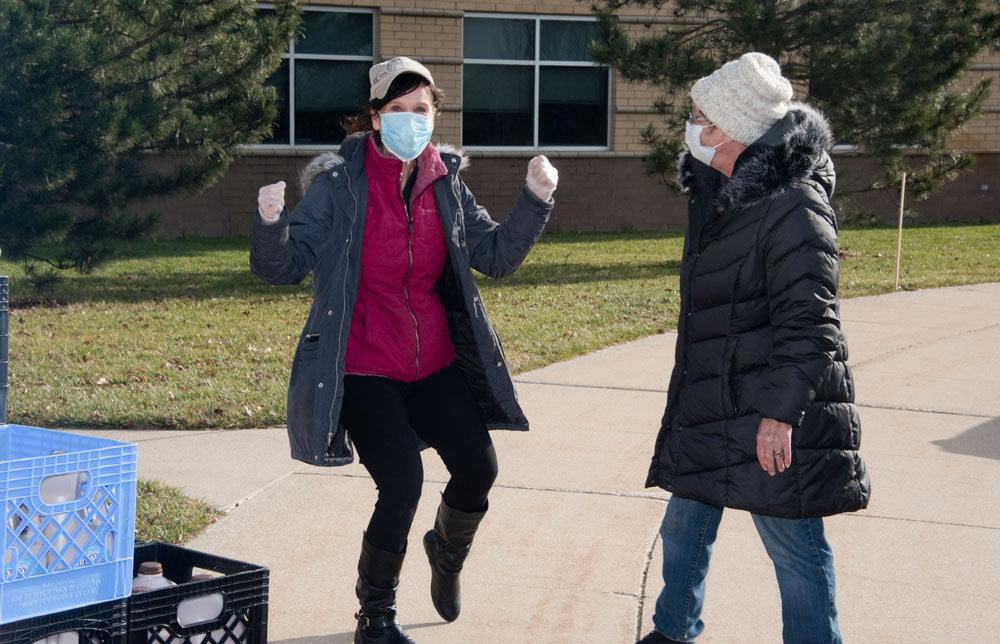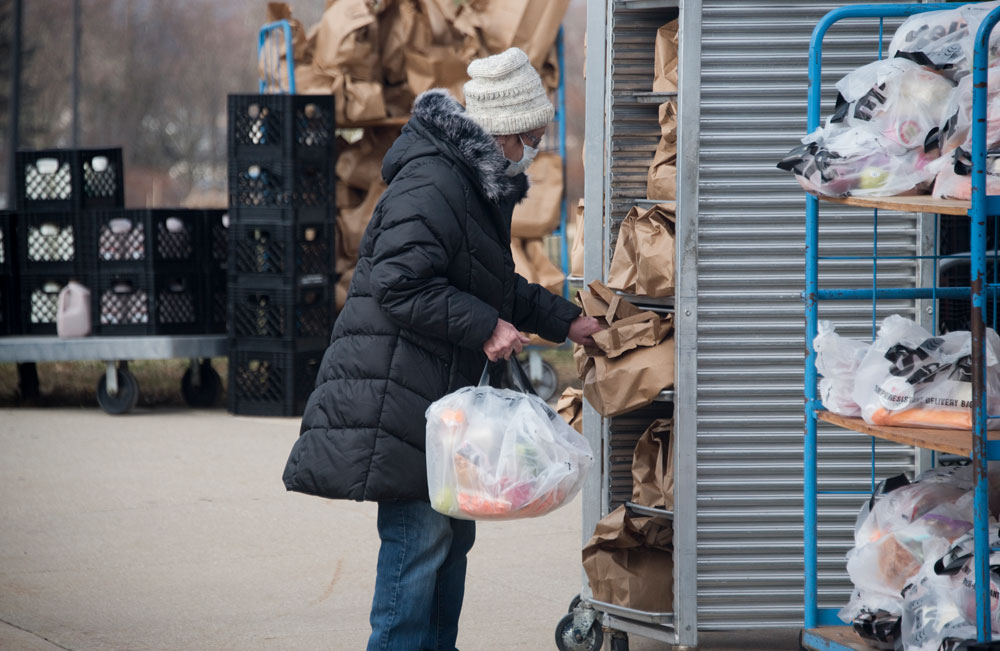Photography by Dianne Carroll Burdick
All Districts – It was a quick turnaround in March for Lowell Area Schools Director of Dining Brad Stinson and food service staff, who successfully went from serving regular school meals to distributing food to families in need after schools closed due to the pandemic.
Since then, when cars lined up steadily for meals, fewer families have recently been coming to receive bags of items. The staff, however, continues to provide “grab and go” lunches at 11 school locations daily, ready for whatever need they see.
“We have seen a need for these meals mostly at the elementary level,” Stinson said. “I anticipate the need to grow as the numbers of COVID cases rise again. We will do whatever we can to help the families in the district.”
While Lowell and other districts are reporting a drop in participation at food distribution sites, the need for food has increased by 21.5 percent compared to last year, according to information from Feeding America West Michigan. The organization estimates that 19.3 percent of children (about 3,000) in Kent County are food insecure, compared to about 9.9 percent (the 2019 level, according to data from the organization) if the pandemic had not happened.

While circumstances vary when it comes to how, where and if people are receiving assistance, schools continue to distribute meals, and food-assistance programs are busily working to get nutritious staples into people’s hands.
“People in their 20s and 30s have been more likely to lose their jobs for pandemic-related reasons than older adults, due perhaps to a lack of seniority in the workplace,” said Juliana Ludema, communication specialist for Feeding America West Michigan. People at this age are also likely to have young children, which is a contributing factor to that spike in hunger. During the pandemic many have sought food assistance for the first time, she said.
Kent ISD Supervisor of Special Populations Casey Gordon, who also is a member of the Kent County Essential Needs Task Force, said there could be several reasons fewer people are visiting school distribution sites. This is a trend that has been seen across the state according to the Detroit Free Press.
“Some of it is because there was confusion over not knowing if the meals were free or not free,” Gordon said.
In the spring, the U.S. Department of Agriculture, which oversees federally funded school meal programs, issued a waiver allowing districts to provide food to any student regardless of if the student attended that school or not. As the 2020-2021 school year got underway, there was confusion surrounding what schools could offer as part of meals and who could receive them. After school started, the USDA issued another waiver allowing all K-12 students within a district, whether eligible according to income or not, to receive free breakfasts and lunches until June 30, 2021.
Many districts also applied and received waivers to provide food to any student, whether in district or not.

Many other factors also impact food-program participation, including if people have transportation, childcare and what their work schedules are.
“If I am a single mother, I may have to bring my entire family to the food distribution site because I have no one to watch the children,” Gordon said, adding that a parent’s ability to come at a certain time to pick up food may be impacted by if the parent is working or helping students with remote learning.
“We also have heard from our families who use public transportation that carrying all that food back and forth can be really difficult.”
The USDA guidelines require that a student take all lunch items, but that can create its own problems. For example, nutritional guidelines require a student to receive milk, which most schools distribute in pint containers. If the parent is picking up five meals each for four students, the parent is then transporting two and half gallons of milk along with all the other lunch items which includes fruits, vegetables, grains, and meat.
Not only is that a heavy load, but Gordon said storage is a concern as well, meaning that milk could go bad before it is even used.
Limited transportation can mean parents have to pick and choose where to go for food assistance.
“If I can only go to one place and I am choosing between feeding just my children or my entire family, I am going to go where I can get the most and feed my entire family,” Gordon said.
The state also has extended other benefits such as the federal Supplemental Nutrition Assistance Program with participants receiving the maximum monthly amount. Godwin Heights’ Director of Dining Services Jamie Schumaker said many of the families in Godwin were able to receive Michigan Bridge Cards, which has had an impact on participation in the district’s grab and go program. Currently the program has about 250 families participating, down from the 1,000 a week in March. Schumaker said the district moved the food distribution to evenings to make it more convenient for families and will be offering meals to any family over the holidays.
A Sense of Routine
School food service directors agreed that consistently providing meals to students brings familiarity to a year full of sudden switches between in-person and virtual classes.
“We have numerous products that we provide as ‘grab and go’ meals that students recognize,” said Grand Rapids Public Schools Director of Food and Nutrition Phillip Greene. “These familiar food items give our students comfort in knowing that GRPS is providing continuous meal service to meet their needs.”
Since the pandemic started, GRPS has expanded its food distribution program to 16 sites providing breakfasts and lunches Mondays, Wednesdays and Fridays from noon to 1:30 p.m.
“School meals are familiar to our students, and there is a great need to continue to provide access to healthy meals,” Greene said. “As the pandemic continues, the need for accessible food service for students will increase.”
Despite trends in other districts, Kenowa Hills Public Schools has seen an increase in the number of families they are serving, jumping from about 1,400 meals in the spring to Thanksgiving week, when the district distributed about 7,400 meals or 615 meal kits of six lunches and six breakfasts.
According to Food Director Shanna Williams, during regular in-person learning, the district is serving almost twice as many breakfasts as compared to last school year with lunch participation being about the same.
“In general, we are very happy with our participation in our weekly meal kits, and serve around 200-250 complete kits each week,” Williams said. That is about 2,400 – 3,000 individual meals per week.

If You Need Help
Anyone in need of food or other services is encouraged to call or text 211, Gordon said. The 211 program of United Way works with area partners, including schools, to provide real-time information on food pantries, school programs and other resources.
Another key resource is the United Way’s Meet Up and Eat Up which will show where school programs are located and times of operation. Kent County also provides information on food programs at assessment.com.
Gordon said because area pantries and food banks work closely together, families can reach out to any of the organizations such as Feeding America West Michigan, Family Network of Wyoming, United Church Outreach Ministry (UCOM), or Kids’ Food Basket, to get connected to food sources in their neighborhood.
Families can also contact their local school, suggested Kent Schools Services Network (KSSN) Operations Manager Brianna Vasquez de Pereira. If the school has KSSN staff, they will be able to connect families to resources, de Pereira said, adding that most schools have community partners willing to help families as well.
Jan Holst, Karen Gentry, Alexis Stark, Beth Heinen Bell and Phil de Haan contributed to this story.



















